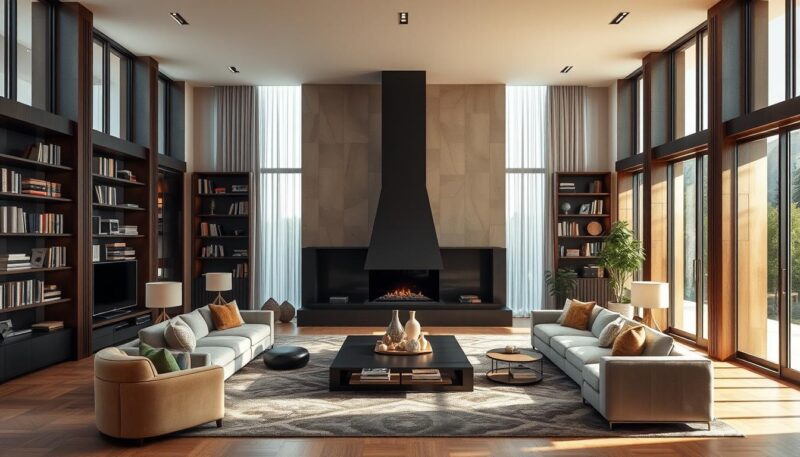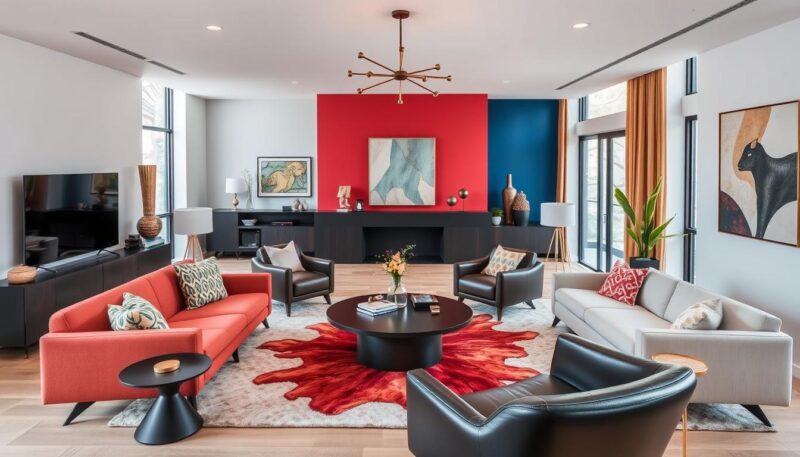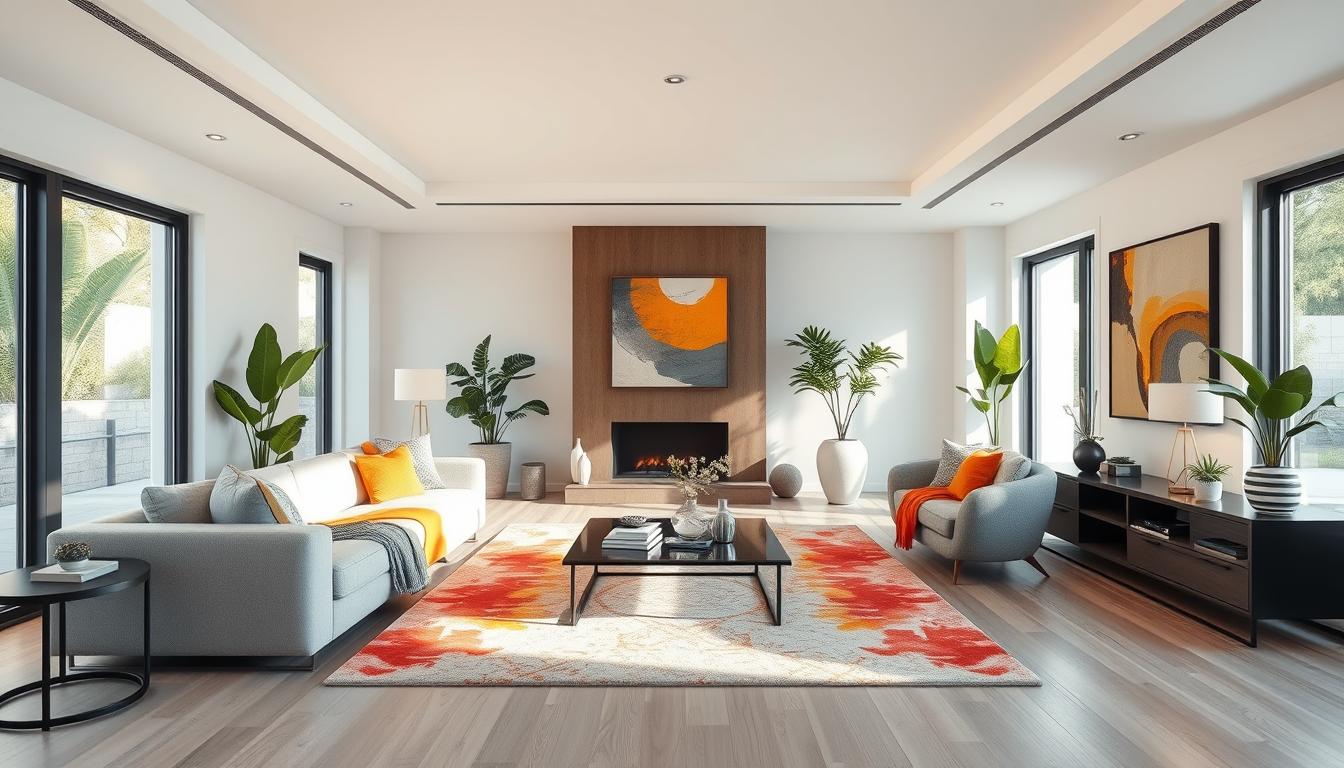Decorating a rectangular living room can feel like a daunting task, but it’s an essential and rewarding process that can transform the energy of your space, cater it to your unique needs, and improve the overall flow. Rectangular living rooms, which are quite common, often present unique challenges due to their shape and size. However, with the right strategies and a bit of creativity, you can create a functional, visually appealing, and comfortable living area that reflects your personal style.
Whether you’re dealing with a long, narrow room or a square-shaped space, the key is to approach your rectangular living room with a plan. By understanding the purpose and function of the room, determining how your family uses the space, and identifying your needs for seating, entertainment, and other activities, you can begin to envision the perfect layout and decor scheme.
Key Takeaways
- Rectangular living rooms present unique layout challenges, but there are strategies to overcome them.
- Defining the purpose and function of the room, as well as your family’s needs, is crucial for a successful design.
- Creating distinct zones within the room using furniture arrangement and rugs can help maximize the space.
- Exploring different furniture placement options, such as across the width or in the corners, can visually widen the room.
- Incorporating focal points and vertical elements can add depth and visual interest to the space.
Understand the Purpose and Function of Your Living Room
Before you embark on decorating your rectangular living room, it’s crucial to understand its purpose and how your family uses the space. This crucial step will guide your decisions on furniture arrangement, seating needs, entertainment requirements, and other activity considerations.
Determine How Your Family Uses the Space
Evaluate how your family currently uses the living room. Is it a hub for relaxation, socializing, or entertainment? Do you have young children who need a safe play area? Or is it a multi-purpose room that serves as a workspace, library, and gathering space? Identifying the primary functions of your living room will help you create a design that caters to your specific needs.
Identify Your Needs for Seating, Entertainment, and Other Activities
Consider the seating requirements for your family and guests. Do you need ample space for a large sectional sofa, or would a loveseat and armchair arrangement work better? Think about your entertainment needs, such as the placement of a TV, sound system, or media console. Additionally, factor in any other activities you’d like to accommodate, like a reading nook, game table, or workspace.
| Furniture and Activity Considerations | Importance (1-5) |
|---|---|
| Comfortable seating (sofa, chairs, etc.) | 5 |
| Entertainment (TV, media console, etc.) | 4 |
| Workspace (desk, shelves, etc.) | 3 |
| Reading/relaxation area | 4 |
| Storage (cabinets, shelves, etc.) | 4 |
By understanding the purpose and function of your living room, you can create a design that caters to your family’s unique needs and ensures the space is both beautiful and practical.
Create Distinct Zones Within the Room
Transforming a rectangular living room into a cohesive and functional space requires strategic zoning. By dividing the area into smaller, distinct zones, you can overcome the “long corridor effect” and create a more inviting atmosphere. Leveraging furniture arrangement and area rugs are effective ways to define these specialized zones within the room.
Divide the Space Into Smaller, Functional Areas
Start by identifying how you and your family use the living room. Do you need a dedicated conversation area, a cozy reading nook, or a media zone for entertainment? Arrange your furniture to create these distinct zones, ensuring each serves a specific purpose. Utilize smaller-scale pieces like armchairs, side tables, and ottomans to define the boundaries of these zones without overwhelming the space.
Use Furniture Arrangement and Rugs to Define Zones
- Position your sofa and loveseat to face each other, creating a natural conversation area.
- Place a comfortable chair and a side table in the corner to establish a reading zone.
- Arrange your media equipment, such as a TV and media console, to form a designated entertainment area.
- Use area rugs to visually delineate the different zones, adding warmth and texture to the space.
By dividing your rectangular living room into distinct zones, you can create a more functional and visually appealing space that caters to your family’s needs. Experiment with furniture placement and the strategic use of rugs to define these specialized areas, avoiding the long corridor effect and ensuring a cohesive flow throughout the room.
How to Decorate a Rectangle Living Room?
Explore Furniture Placement Options Across the Width
When decorating a rectangular living room, it’s essential to avoid the common mistake of lining up furniture along the long walls. This can create a “corridor effect” and make the space feel narrow and confined. Instead, consider placing your sofa across the width of the room to break up the long lines and create a wider, more balanced feel.
Utilize Corners for Cozy Nooks and Storage Solutions
The corners of a rectangular living room can be utilized to add visual interest and functionality to the space. Consider placing an armchair or creating a cozy reading nook in the corners to maximize the use of these often-overlooked areas. Additionally, you can incorporate storage solutions, such as built-in shelves or cabinets, to keep the room organized and tidy.
Proper furniture placement and the strategic use of corners can transform a rectangular living room into a welcoming and visually appealing space. By avoiding the common mistake of lining up furniture along the long walls and instead focusing on furniture placement options across the width and utilizing the corners, you can create a room that feels wider, more balanced, and tailored to your needs.
| Furniture Placement Recommendation | Benefit |
|---|---|
| Place the sofa across the width of the room | Breaks up long lines and creates a wider, more balanced feel |
| Utilize corners for cozy nooks and storage solutions | Adds visual interest and functionality to the space |
| Avoid lining up furniture along long walls | Prevents the “corridor effect” and makes the room feel more open |
“Paying attention to scale and proportion is crucial to avoid overcrowding or leaving a space feeling empty. Achieving balance and symmetry through evenly distributed furniture and décor elements enhances the room’s aesthetics.”
Incorporate Focal Points and Vertical Elements
In a rectangular living room, incorporating focal points and vertical elements can make a significant difference in enhancing the overall visual appeal and creating a sense of balance. By identifying or creating a strong visual anchor, you can draw the eye and establish a harmonious flow throughout the space.
Identify or Create a Visual Anchor for the Room
Consider incorporating a striking focal point, such as a fireplace, a large piece of artwork, or a media unit. This central element can serve as a visual anchor, grounding the room and guiding the eye through the space. Positioning your furniture arrangement around this focal point can help create a cohesive and visually appealing layout.
Add Height with Shelving Units, Artwork, and Lighting
- Incorporate tall shelving units along the walls to draw the eye upward and add a sense of height to the room. These vertical elements can be used to display decorative accessories, books, or other meaningful items.
- Hang oversized or vertical artwork, such as tall paintings or floor-to-ceiling gallery walls, to create a focal point and add visual interest to the space.
- Layer lighting throughout the room, using a combination of floor lamps, wall sconces, and pendant lights to create a sense of depth and disruption the long, narrow feel of the rectangular living room.
By strategically incorporating focal points and vertical elements, you can effectively transform a rectangular living room, creating a visually compelling and balanced space that feels open and inviting.

Balance with Color, Pattern, and Texture
When decorating a rectangular living room, balancing the use of color, pattern, and texture can be a game-changer. Rather than focusing solely on the long walls, consider using color blocking or accent walls on the shorter end walls to visually shorten the room and break up those long lines. This strategic approach, combined with the strategic placement of different shapes, textures, and furniture styles, can create a more visually engaging and cohesive space.
Use Color Blocking or Accent Walls to Visually Shorten the Room
One effective technique for balancing the proportions of a rectangular living room is the use of color blocking or accent walls. Instead of painting all the walls in a single color, consider using a bold, contrasting hue on the shorter end walls. This visual trick can help to visually “shorten” the room, creating a more balanced and inviting atmosphere.
Experiment with different color combinations and patterns to find the right balance. Soft, muted tones can create a serene and calming ambiance, while bolder, more vibrant shades can add a dynamic and lively feel to the space. Incorporate textures, such as wallpapers, fabrics, and decorative elements, to add depth and visual interest to the room.
| Color Scheme | Mood | Recommended Decor |
|---|---|---|
| Soft blue-green and white | Calming, serene | White slipcovers, patterned throw pillows, natural textures |
| Bubblegum pink and navy blue | Vibrant, playful | Patterned curtains, bold accent furniture, mix of textures |
| Kelly green and yellow | Energetic, sunny | Patterned rugs, colorful artwork, natural wood accents |
Remember, the key is to find the right balance between color, pattern, and texture to create a visually stunning and cohesive living room design that feels both inviting and tailored to your personal style.
Mix Shapes and Styles for Visual Interest
When decorating a rectangular living room, mixing different shapes and furniture styles can be a powerful way to disrupt the inherent linearity of the space and create a visually captivating atmosphere. By combining rectangular and circular elements, as well as incorporating diverse furniture styles and decor accents, you can avoid a monotonous look and infuse your living room with a dynamic, curated aesthetic.
Combine Rectangular and Circular Elements
Pairing a rectangular sofa with a round coffee table, for instance, can help balance the proportions of the room and add depth to the overall design. This interplay of shapes introduces a sense of visual rhythm and prevents the space from feeling too boxy or one-dimensional. Experiment with other circular accents, such as pendant lights, side tables, or decorative mirrors, to further accentuate the interplay of forms.
Incorporate Different Furniture Styles and Decor Accents
Blending furniture styles from different eras and design aesthetics can lend your living room a unique, curated feel. Consider pairing a mid-century modern armchair with a traditional sofa, or juxtaposing a sleek, contemporary media console with a vintage area rug. Incorporate diverse decor accents, such as textured throw pillows, ceramic vases, or metallic wall sconces, to create a cohesive yet visually interesting space that avoids monotony.
| Percentage of Homes Using Mismatched Furniture Styles | Importance of Atmosphere and Mood |
|---|---|
| Increasing trend noted in warm minimalist and Scandinavian interiors | Subset of cohesive design in eclectic homes; determining desired atmosphere can guide furniture choices |
Remember, the key to successfully mixing shapes and styles is to focus on balance and intentionality. Repeat a chosen color, finish, material, or pattern two to three times in the space to create a cohesive and curated look. By thoughtfully blending rectangular and circular elements, as well as diverse furniture styles and decor accents, you can transform your rectangular living room into a visually captivating and inviting haven.

Optimize Lighting and Flow
Achieving the perfect balance of lighting and traffic flow is crucial in decorating a rectangular living room. By maximizing natural light and utilizing layered lighting, you can enhance the functionality and ambiance of the space, while ensuring proper circulation and unobstructed pathways.
Maximize Natural Light and Use Layered Lighting
One of the key strategies for optimizing lighting in a rectangular living room is to make the most of natural light. Position your seating arrangements and furniture to take advantage of any available windows, allowing the natural illumination to flood the room. Complement this with a well-designed layered lighting system, incorporating a combination of overhead fixtures, wall-mounted sconces, and strategic placement of table lamps. This layered approach creates a warm and inviting atmosphere, while also providing the necessary task lighting for various activities.
Ensure Proper Circulation and Traffic Flow
Considering the flow of traffic is essential in a rectangular living room. Arrange your furniture in a way that allows for unobstructed pathways, making it easy for people to move around the space without feeling cramped or confined. Leave ample space between the sofa and coffee table, and consider the placement of ottomans, armchairs, and other pieces to facilitate smooth circulation. By optimizing the layout, you can enhance the overall functionality and ambiance of the room, creating a space that is both visually appealing and practical.
| Lighting Strategies | Traffic Flow Considerations |
|---|---|
|
|
By optimizing lighting and ensuring proper circulation, you can create a rectangular living room that is both visually stunning and highly functional, enhancing the overall ambiance and experience of the space.
Conclusion
In conclusion, decorating a rectangular living room requires a thoughtful approach that considers the room’s purpose, functionality, and visual balance. By understanding how your family uses the space, creating distinct zones, strategically arranging furniture, incorporating focal points and vertical elements, and balancing color, pattern, and texture, you can transform your rectangle living room into a cozy and functional haven that reflects your personal style and meets your needs. The expert tips and strategies outlined in this article can help you create a personalized solution for your unique space.
From maximizing storage and traffic flow to achieving a visually appealing layout, the insights provided in this guide offer a comprehensive roadmap for making the most of your rectangular living room. Whether you prefer a traditional, contemporary, modern, or formal aesthetic, the versatility of this room shape allows you to tailor the space to your specific preferences and requirements. By embracing the challenges and opportunities of a rectangle living room, you can create a harmonious and inviting environment that serves as the heart of your home.
With the right balance of function and style, your rectangular living room can become a multifunctional oasis that caters to your family’s diverse needs. From cozy reading nooks to sophisticated entertaining areas, the possibilities are endless when you approach the design with a keen eye for detail and a willingness to experiment. By following the principles outlined in this article, you’ll be well on your way to crafting a rectangle living room that not only looks stunning but also feels like a true reflection of your personal taste and lifestyle.
FAQ
What are the key considerations when decorating a rectangular living room?
The key considerations include understanding the purpose and function of the living room, creating distinct zones within the space, exploring furniture placement options, incorporating focal points and vertical elements, balancing color, pattern, and texture, and optimizing lighting and flow.
How can I determine the purpose and function of my rectangular living room?
To determine the purpose and function of your living room, you should identify how your family uses the space and what your needs are for seating, entertainment, and other activities. This will inform the furniture arrangement and layout decisions.
What strategies can I use to create distinct zones within a rectangular living room?
You can create distinct zones within the rectangular living room by dividing the space into smaller, functional areas using furniture arrangement and area rugs. This can help overcome the “corridor effect” and make the space feel more cohesive.
How can I optimize the furniture placement in a rectangular living room?
Instead of lining up the furniture along the long walls, try placing the sofa across the width of the room to break up the long lines and make the space feel wider. Utilize the corners of the room for cozy nooks and storage solutions.
What role do focal points and vertical elements play in decorating a rectangular living room?
Identifying or creating a visual anchor, such as a fireplace or a large piece of artwork, can help ground the space and draw the eye. Adding height with elements like shelving units, tall artwork, and layered lighting can disrupt the long, narrow feel of the rectangular living room.
How can I balance color, pattern, and texture in a rectangular living room?
Use color blocking or accent walls on the shorter end walls to visually shorten the room and break up the long lines. Incorporate different shapes, textures, and furniture styles to create a more visually interesting and cohesive space.
What tips can help optimize the lighting and flow in a rectangular living room?
Maximize natural light through strategic window placement and use layered lighting, such as a combination of overhead, wall-mounted, and table lamps, to create a warm and inviting atmosphere. Ensure proper circulation and traffic flow by considering the placement of furniture and creating unobstructed pathways.
Source Links
- https://www.thelivinghouse.co.uk/blog-interior-design-tips/how-to-design-your-rectangular-living-room
- https://www.thespruce.com/rectangle-living-room-layout-8638605
- https://www.theorganizedmama.com/rectangular-living-room-layout/
- https://www.ramblingrenovators.ca/2023/04/how-to-arrange-furniture-in-long-narrow-living-room.html
- https://www.coohom.com/article/rectangle-living-room-design-ideas
- https://stylebyemilyhenderson.com/blog/design-pass-room-reveal-portland-family-room
- https://laurengilberthorpeinteriors.com/layouts-rectangular-sitting-rooms/
- https://www.linkedin.com/pulse/8-creative-hacks-rectangular-living-room-design-decasa-collections
- https://www.houzz.com.au/magazine/16-clever-ways-to-create-zones-in-open-plan-spaces-stsetivw-vs~27282063
- https://www.spoak.com/layouts?room_type=living_room&room_shape=rectangle
- https://www.settingforfour.com/how-to-arrange-furniture-in-a-rectangular-living-room/
- https://www.architecturaldigest.com/story/small-living-room-ideas
- https://www.theinteriordesigninstitute.com/blog-tips-for-working-with-the-seven-elements-of-design
- https://livingroomlay.com/rectangular-living-room-layout-with-tv/
- https://www.bhg.com/decorating/color/schemes/living-room-color-schemes/
- https://www.therootsofhome.com/2023/03/how-to-use-pattern-and-texture-in-room.html
- https://www.homesandgardens.com/advice/how-to-mix-patterns-in-a-room
- https://mixandmatchdesign.com/new-blog/living-room-layout-ideas
- https://havenly.com/blog/mixing-furniture-styles
- https://housedesigner.com/arranging-furniture-in-a-rectangular-living-room-layout-tips-and-tricks/
- https://livingwithlolo.com/how-to-arrange-furniture-in-rectangular-living-room/
- https://chapinfurniture.com/blogs/living/maximizing-space-practical-tips-for-furniture-layout-in-your-rectangle-living-room?srsltid=AfmBOoriBuKv1Pl5fvGSDr4rGNXtxaZw6nPj_F52p_C0q6AwIDs4LJ1a
- https://www.thedecorholic.com/4-rectangle-living-room-layout-ideas/
- https://dphome.my/blogs/living-room/how-to-arrange-furniture-in-a-rectangular-living-room
